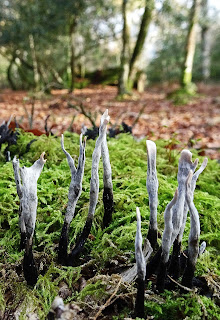 |
| Seasonal pond at Nomansland Green. MW |
Sandra, Marge & Marlene Covid-bubbled round this 2.5miles circuit on a sunny morning cooled by a stiff breeze. From opposite the Lamb Inn we stumbled through trees at the back of the Green to the path along the back fence of the old forest cottage. During a diversion along the side fence to see Sulphur Tuft (Hypholoma fasciculare) perched on fallen logs, we were pestered by a large, grey horse that crept up behind us with evil intent; leaning over the paddock wire it sank its teeth into anorak and rucksack, luckily well padded.
 |
| Sulphur Tuft (Hypholoma fasciculare) MR |
Somewhat chewed, we made a hasty exit down the path through mixed woodland, tramping in thick, leafy layers below spindly birch and large beech, now almost bare, though oak was hanging on to rich-brown leaves. The little gully we crossed was in modest flow after recent rain that had benefited the bright, feathery tufts of Hard Fern (Blechnum spicant) overhanging the bank.
 |
| Hard Fern (Blechnum spicant) MW |
Joining a wide ride we continued downhill then turned left uphill towards Bramshaw Wood carpark. Several trees have fallen here over the years in messy tangles, bearing more Sulphur Tuft and stacks of Turkey Tail (Trametes versicolor). Tiny, glistening-white clumps of Porcelain Fungus (Oudemansiella mucida) contrasted with the hard, black blobs of King Alfred’s Cakes/Cramp Balls (Daldinia concentrica). Missing our field companions, we struggled with identifying some fungi but thought they might be Mycena sp. and/or Russula sp.
Just short of the parking area we turned south-east onto the old Church Path. Heading steadily downhill, ignoring any side paths, we reached a bog, dry-ish in summer but now very wet. Apart from some clumps of black and grey Candlesnuff (Xyaria hypoxylon) on mossy mounds, the only creature of note was a large golden retriever, revelling in traipsing through the mud up to its belly, clearly on borrowed time pending the arrival of the owner.
 |
| Candlesnuff (Xyaria hypoxylon) MW |
 |
| Turkey Tail (Trametes versicolor) MR |
 |
| Cramp Balls (Daldinia concentrica) SP |
Beside the path are some notable trees including a bulbous oak and con-joined beech and oak forever intertwined. A few yards along the road brought us to St. Peter’s at Bramshaw. A church on this site dates from Anglo-Saxon times but the current building has 3 main periods of construction: 13th. 15th. and 19th centuries and was partly in Wiltshire until the 1890s when the boundary was shifted. There are splendid rural views from the church mound and an extensive graveyard around and behind. The back stile leads into a meadow; currently cut to rough pasture, but where long grasses and buttercups grow in summer, providing hay for the winter. Following the path from the bottom left-hand gate we then swung north to reach the Newbridge road, passing a mysterious arrangement of 3 huge, cut trunks of oak with no sign nearby of their basal stump. We turned towards the Bramshaw road then cut the corner as far as the cattle grid for the final uphill stretch from Woodside Bottom to the Lamb. |
| SP |
Birds were clearly otherwise engaged this morning, making brief appearances or just calling from afar. Hence, we bagged only Blackbird, Blue Tit, Carrion Crow, Common Buzzard (heard), Jackdaw, Nuthatch (heard), Robin and Woodpigeon. MW/SP/MR







